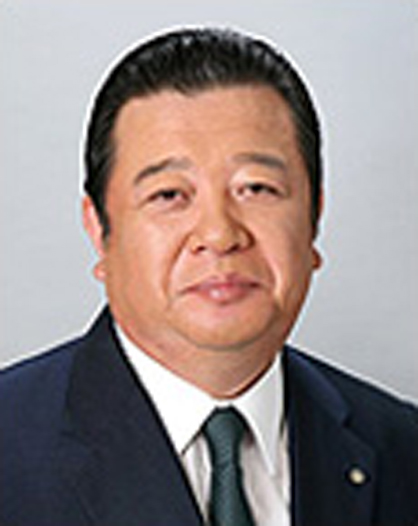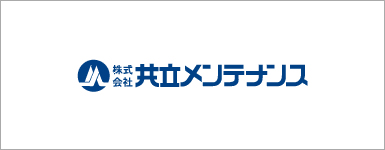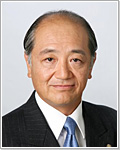| Kyoritsu Maintenance (9616) |
|
||||||||||||||
Company |
Kyoritsu Maintenance Co., Ltd. |
||
Code No. |
9616 |
||
Exchange |
TSE 1st Section |
||
Chairman |
Haruhisa Ishizuka |
||
President |
Mitsutaka Sato |
||
HQ Address |
Soto Kanda 2-18-8, Chiyoda-ku, Tokyo |
||
Year-end |
March |
||
URL |
|||
* Share price as of closing on June 14. Number of shares outstanding as of most recent quarter end, do not include treasury shares.
|
||||||||||||||||||||||||
|
|
* Estimates are those of the Company.
|
|
| Key Points |
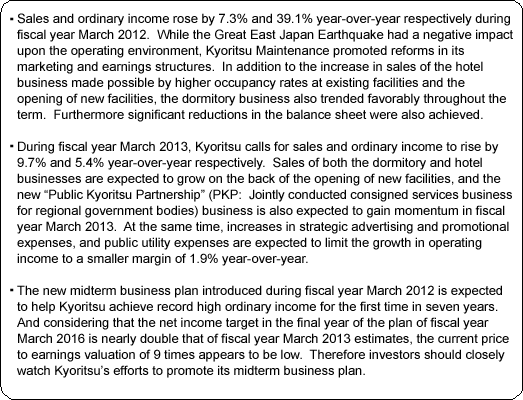 |
| Company Overview |
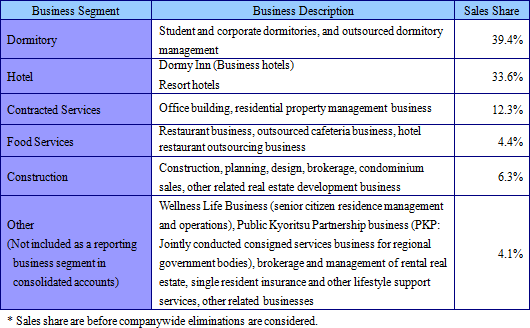 <Corporate History>
Kyoritsu Maintenance was established in September 1979. The founder, Haruhisa Ishizuka, had long been associated with the food service industry and started the Company by taking on the operations of corporate cafeteria facilities on a consigned basis. In the following year in 1980 in Sakura City, Chiba Prefecture, the Company established a two story wooden structure with 28 small four Japanese straw mat rooms as its first dormitory facility. Based on the principle of providing "food" that "fosters the health and well being of students to put their parents' minds at ease," Kyoritsu was able to steadily expand its student dormitory business through partnerships with various schools. The Company steadily expanded its operating territory to cover the Tokyo, Kanagawa, Nagoya and Osaka regions. In April 1985, Kyoritsu began offering employee dormitories that offered highly unique features of "individual rooms with commissary functions providing breakfast and dinner," and "large bathing facilities" as a comforting amenity for residents. In June 1993, the Company moved its headquarters to its current location and in July of the same year they entered the resort hotel business with the opening of a facility in Nagano Prefecture, followed by their entry to the business hotel realm in August with the opening of a facility in Saitama Prefecture. In September 1994, Kyoritsu listed its shares on the JASDAQ Market (At the time called the OTC Market), in March 1999 it moved its listing to the Second Section of the Tokyo Stock Exchange, and then to the First Section in September 2001.
|
| Midterm Business Plan "Kyoritsu Value Up Plan!" (From FY3/12 to FY3/16) |
 (1) Accelerate Growth in Its Core Business
① "Tokyo Region Dormitory 98 Project"
The "Tokyo Region Dormitory 98 Project" is a plan that calls for efforts to raise occupancy rates in the Tokyo metropolitan region, which accounts for 65% of the total dormitory capacity, to 98% at the start of the term (95.6% in FY3/13).
 ② Pinpoint Development
With regards to development, Kyoritsu is developing facilities in areas that are in high demand by clients (Universities, companies) as part of a focused "pinpoint" facility development strategy. As part of this strategy, collaboration with financial institutions, real estate companies, trading firms, and general contractors is being strengthened to expand the breadth of information obtained. Furthermore as an exit strategy, a "sale and lease back plan" is being implemented to increase the liquidity of its assets. Moreover, the announcement effect of asset sales to J-REITs in fiscal year March 2011 led to a pronounced increase in inquiries to purchase the company' s assets (Asset sales in fiscal year March 2011 and 2012 totaled ¥14.0 and ¥4.8 billion respectively).
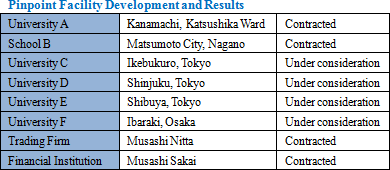 ③ Dormy Inn Overseas Deployment
As part of the Company' s globalization strategy, they are considering the deployment of Dormy Inn business hotels in overseas markets with preparations for the opening of the first facility being conducted in Korea (Expected to be opened in Spring 2013).Overview of Overseas Facility Candidate
(2) Cultivating New Businesses
During fiscal year March 2012, the Public Kyoritsu Partnership business was launched. This business provides integrated services ranging from consulting to outsourcing services designed to match the needs of regional governments undergoing administrative and fiscal reforms. Kyoritsu will take on the non-core services of the government, and contribute to the administrative and fiscal reforms by leveraging its knowhow to reduce costs, provide stable regional employment opportunities, and improve resident services.
① Consigned Services Details
The main consigned services include management of various facilities and operation of various services, and vehicle operations management. They also include total operations of various regional welfare services, rejuvenation of tourism, facilitation of public assets, and other cross sectional activities designed to support rejuvenation of regional economies.Specific Details:
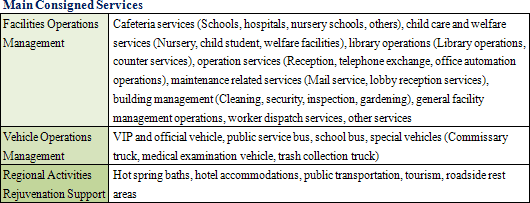 ② First Fiscal Year Results (FY3/12)
In the first year of the plan of fiscal year March 2012, Kyoritsu took on comprehensive consignment of facilities in Yubetsu Town, Hokkaido and Hidakagawa Town, Wakayama Prefecture, and it has signed contracts with 16 regional government bodies for 37 facilities for total sales of ¥910 million. During fiscal year March 2013, Kyoritsu expects to sign contracts with 64 regional government bodies for 104 facilities for total sales of ¥3.06 billion, and it has already concluded contracts for a total of ¥1.6 billion.
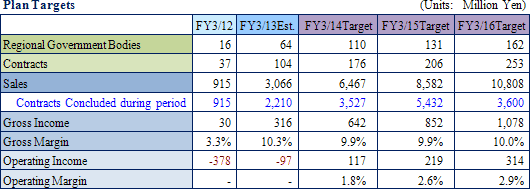 (3) Numerical Targets
 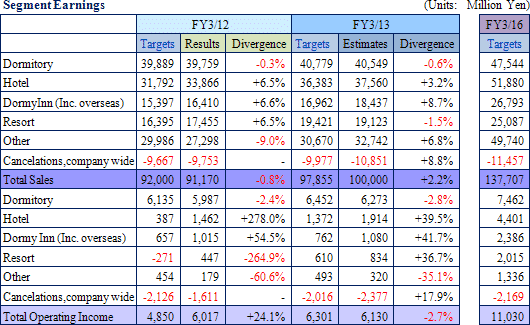 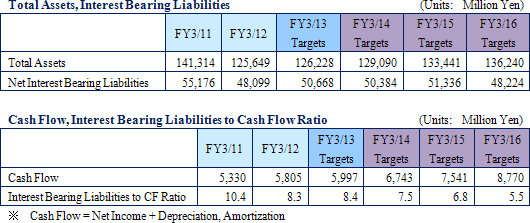  |
| Fiscal Year March 2012 Earnings Results |
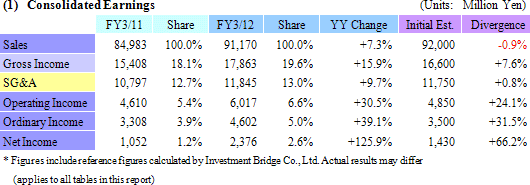 Sales and Ordinary Income Rise 7.3% and 39.1% Year-Over-Year
Sales rose by 7.3% year-over-year to ¥91.17 billion. While the Great East Japan Earthquake disaster (The earthquake disaster) had a negative impact upon Kyoritsu' s business, the hotel business sales increased on the back of new facility openings and increases in occupancy rates at existing facilities, and the dormitory business trended favorably throughout the entire term. With regards to profits, the hotel business acted as a driver of strong growth with its operating income rising 4.3 times and allowing overall operating income to grow by 30.5% year-over-year. Losses at the extraordinary level declined and allowed net income to rise by about 2.3 times year-over-year. Furthermore, while operating income rose by ¥1.4 billion, the business hotel and resort hotel segments accounted for ¥780 million and ¥340 million of this increase, respectively (Dormitory business accounted for ¥120 million). A yearend dividend of ¥19 per share is expected to be paid (Combined with the midterm dividend for a full year dividend of ¥38).
  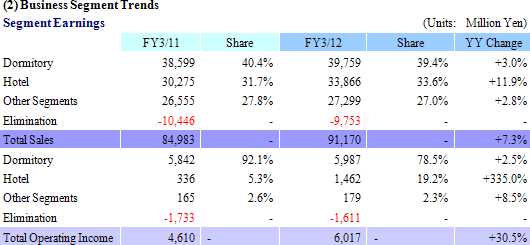 Dormitory Business
The number of facilities operated (Excluding facilities managed on a consigned basis) as of the end of the fiscal year grew by seven from the end of the previous term to 419, and the number of residents capacity rose by 649 to 32,309 over the same period. At the same time sales and operating income rose by 3.0% and 2.5% year-over-year to ¥39.75 and ¥5.98 billion respectively over the same period. Furthermore, Kyoritsu' s efforts to reduce vacancies through marketing activities before the end of the term were successful in allowing occupancy rates at the beginning of the term to rise by 1.2% points to 96.5% at the start of fiscal year March 2013.Conditions by type of dormitories are provided below. Student Dormitories (Sales rose 2.8% year-over-year to ¥23.642 billion)
Despite various structural issues including the declining number of children in Japan, increases in advancement rates of students to universities and vocational schools, and promotion of admission of regional students to four year universities led to increased demand for student dormitories. And while the earthquake disaster led foreign students and students from the disaster affected regions to cancel their applications to enter dormitories, fortification of relationships with existing educational institutions contributed to an increase in occupancy rates at the start of fiscal year March 2013 to 95.3% from 92.9% at the start of fiscal year March 2012. Relationships were newly established with the Tokyo University of Science, Kobe City University of Foreign Studies, University of Tokyo Health Sciences, and University of Marketing and Distribution Sciences, and the number of contracted residents at the end of the term rose by 5.1% year-over-year to 19,115.
Corporate Dormitories (Sales rose 2.2% year-over-year to ¥9.324 billion)
The operating environment remained difficult due to declines in both the working population and new graduates of 4.5% and 19.8% year-over-year to 59.77 million and 581,000 respectively. However new contracts with major corporations for use of facilities as new employee training facilities (Nippon Life Insurance Company, Nomura Securities Co., Ltd., major general contractors and other companies) allowed the number of residents to rise by 0.2% year-over-year to 7,738 at the end of the fiscal year. Kyoritsu was also successful in cultivating short term resident contracts in the Sendai region on the back of the disaster relief efforts.
Domeal (Studio Type Condominiums) Business (Sales rose 3.0% year-over-year to ¥3.584 billion)
In response to diversifying needs of students to live alone and demand for individual contracts for single worker dormitories, Kyoritsu' s efforts to leverage referrals of residents from partnering schools and corporations and the shift of residents from dormitories with cafeteria services allowed the number of contracted residents to rise by 3.0% year-over-year to 4,177 at the end of the term.Aside from these factors, strong demand for consigned management of corporate and university owned dormitory facilities led to a 7.2% year-over-year increase in sales to ¥3.207 billion. 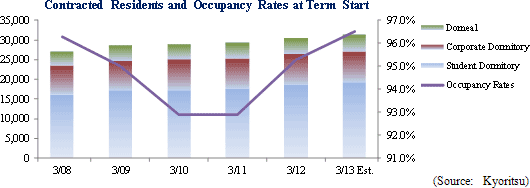 Hotel Business
The number of facilities rose by four from the end of the previous term (Newly opened: 3 business hotels, 1 resort hotel) to 63 at the end of the current term, with the number of rooms rising by 591 to 9,497 over the same period. Sales and operating income rose by 11.9% and 335.4% year-over-year to ¥33.86 and ¥1.46 billion respectively.
Dormy Inn (Business Hotel) Business (Sales rose 14.2% year-over-year to ¥16.410 billion)
Amidst the industry wide trend for hotels to reduce value addition and focus upon only sleeping accommodations, Kyoritsu' s has sought to differentiate its services and facilities by providing "large hot spring type bathing facilities" and "good tasting breakfast menus." During fiscal year March 2012, this differentiation strategy was successful in the difficult task of capturing pleasure travelers at its business hotels, and matched the needs of business travelers to create favorable demand for their business hotels (Some facilities benefitted from disaster relief related demand). The three new facilities of "Natural Hot Spring Fugaku no Yu, Dormy Inn Mishima," "Natural Hot Spring Shirasagi no Yu Dormy Inn Himeji," and "Natural Hot Spring Sodeminato Dormy Inn PREMIUM Hakata Canal City Front" were opened during the term.
Resort Hotel Business (Sales rose 9.7% year-over-year to ¥17.455 billion)
The resort hotel business maintains a principle of providing "reasonable and high quality resort lifestyles" and ensuring that all customers enjoy "comfortable accommodations." During fiscal year March 2012, the "Kyoto Arashiyama Hot Springs Kadensho" was newly opened. Existing facilities were negatively impacted by the earthquake disaster and the subsequent restraint in pleasure travel, but the creation of new packaged services designed to raise occupancy rates on weekdays and successful marketing strategies allowed Kyoritsu to capture demand during the peak summer resort season and year end travel season.
 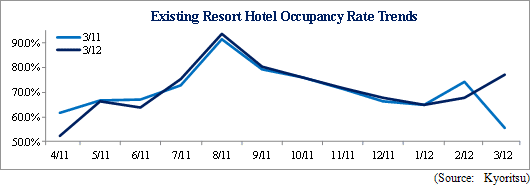 Other Business
A decline in construction business sales was offset by higher sales of other businesses and allowed other business segment sales to rise by 2.8% year-over-year. With regards to profits, intensified pricing competition in the contracted services business and the start of the new PKP business contributed to reduced earnings. But contributions from construction work for new condominiums for sale, the food services business, and worker dispatch businesses allowed operating income to rise by 8.5% year-over-year to ¥170 million.
(3) Financial Conditions and Cash Flow
The increase in liquidity of real estate assets (3 Dormy Inns, 1 dormitory, and 1 studio type dormitory facilities were sold under a "sale and leaseback" scheme. In value terms, this strategy of raising the liquidity of Kyoritsu' s balance sheet led to a ¥4.8 billion reduction in fixed assets) allowed capital reserves to be used to reduce interest bearing liabilities. Subsequently total assets declined by ¥15.66 billion from the end of the previous term.
  |
| Fiscal Year March 2013 Earnings Estimates |
 Sales and Ordinary Income Expected to Rise 9.7% and 5.4% Year-Over-Year
Kyoritsu expects sales to rise by 9.7% year-over-year to ¥100.0 billion in fiscal year March 2013. Contributions from newly opened facilities, increases in sales of the dormitory and hotel businesses, and higher sales of new businesses including the PKP business are attributed to the Company' s outlook for higher sales. With regards to profits, a ¥350 million increase in public utility costs due to electric power price hikes, ¥40 million to establish a special subsidiary to accommodate hiring of employees with special challenges, ¥180 million in advertising and promotional costs to strengthen the Kyoritsu Maintenance brand, and higher amortization costs for systems are expected to limit the increase in operating income to 1.9% year-over-year. Improvements in non-operating income arising from reductions in financial expenses are expected to be offset by the disappearance of extraordinary income and further reduce the increase in net income to a 0.6% year-over-year margin to ¥2.39 billion.
 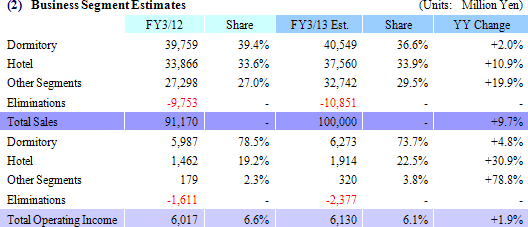 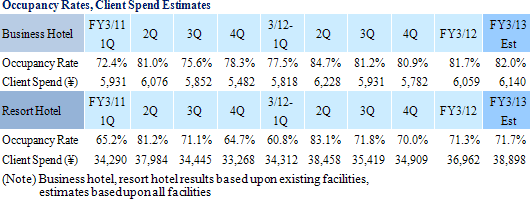 |
| Conclusions |
|
In light of these results, Kyoritsu now calls for record high ordinary income to be achieved for the first time in seven years during fiscal year March 2013. And while the hike in electric power rates is expected to cause operating income to fall slightly below targets called for in the midterm business plan, a larger than expected improvement in financial balance is expected to allow ordinary income to exceed targets of the plan. If Kyoritsu can successfully achieve the final year targets established in the midterm business plan for fiscal year March 2016, net income would nearly double from fiscal year March 2013 levels. Furthermore, a stock buyback operation was successfully conducted from November 2011 to January 2012 and further buyback operations will be considered as financial conditions allow. The stock buyback operations combined with the increase in net income to put Kyoritsu' s shares at relatively low valuations of just over 9 times price to earnings ratio (PER), 0.7 times price to book ratio (PBR), and a high 2.4% dividend yield. Therefore investors should watch Kyoritsu' s near term efforts to implement its midterm business plan closely. This report is intended solely for information purposes, and is not intended as a solicitation to invest in the shares of this company. The information and opinions contained within this report are based on data made publicly available by the Company, and comes from sources that we judge to be reliable. However we cannot guarantee the accuracy or completeness of the data. This report is not a guarantee of the accuracy, completeness or validity of said information and or opinions, nor do we bear any responsibility for the same. All rights pertaining to this report belong to Investment Bridge Co., Ltd., which may change the contents thereof at any time without prior notice. All investment decisions are the responsibility of the individual and should be made only after proper consideration.
Copyright(C) 2012 Investment Bridge Co., Ltd. All Rights Reserved.
For back numbers of Bridge Reports on Kyoritsu Maintenance Co., Ltd. (9616), please go to our website at the following url. www.bridge-salon.jp/ |

